Related Research Articles

The Shiba Inu is a breed of hunting dog from Japan. A small-to-medium breed, it is the smallest of the six original dog breeds native to Japan. Its name literally translates to "brushwood dog", as it is used to flush game.

A dog breed is a particular type of dog that was purposefully bred by humans to perform specific tasks, such as herding, hunting, and guarding. Dogs are the most variable mammal on Earth, with artificial selection producing upward of 360 globally recognized breeds. These breeds possess distinct traits related to morphology, which include body size, skull shape, tail phenotype, fur type, body shape, and coat colour. However, there is only one species of dog. Their behavioral traits include guarding, herding, and hunting, and personality traits such as hyper-social behavior, boldness, and aggression. Most breeds were derived from small numbers of founders within the last 200 years. As a result of their adaptability to many environments and breedability for human needs, today dogs are the most abundant carnivore species and are dispersed around the world.
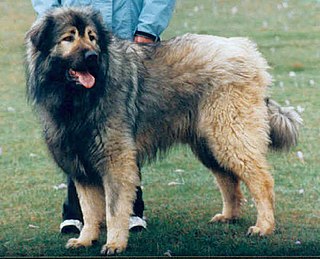
The Šarplaninac or Sharr dog is a breed of dog of livestock guardian type. It is named for the Šar Mountains or Šar Planina range in the Balkans, where it is principally found. It was recognised by the Fédération Cynologique Internationale as the Illyrian Shepherd Dog or Ilirski Ovčar from 1939 until 1957, when the name was changed to Yugoslavian Shepherd Dog – Sharplanina or Jugoslovenski Ovčarski Pas – Šarplaninac.
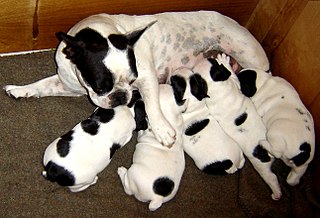
Dog breeding is the practice of mating selected dogs with the intention of maintaining or producing specific qualities and characteristics. When dogs reproduce without such human intervention, their offspring's characteristics are determined by natural selection, while "dog breeding" refers specifically to the artificial selection of dogs, in which dogs are intentionally bred by their owners. Breeding relies on the science of genetics, hence a breeder who is knowledgeable on canine genetics, health, and the intended purpose of the dogs attempts to breed suitable dogs.

A working dog is a dog used to perform practical tasks, as opposed to pet or companion dogs.
A show dog might refer to any dog entered into a dog show. More specifically, a show dog is a dog which has been specially bred, trained, and/or groomed to conform to the specifications of dog shows, so as to have a chance of winning. Often used as a single word (showdog), the term is also used within the sport of conformation to refer to a dog that displays a particularly energetic or outgoing character.

Prey drive is the instinctive inclination of a carnivore to find, pursue, and capture prey. The term is chiefly used to describe and analyse habits in dog training.

A bark is a sound most often produced by dogs. Other animals that make this noise include, but are not limited to, wolves, coyotes, foxes, seals, frogs, and barking owls. "Bark" is also a verb that describes the sound of many canids.

The Maremmano-Abruzzese Sheepdog, also known as the Maremmano, Maremma Sheepdog, or Abruzzese Sheepdog, among other names, is an Italian breed of livestock guardian dog. It is indigenous to Central Italy, especially to the Maremma region of Tuscany and Lazio, and to northern areas of Southern Italy, particularly to Abruzzo. It has been used for centuries by Italian shepherds to guard sheep from wolves. The "Maremmano" name derives from that of the Maremma marshlands where, until recently, shepherds, dogs and hundreds of thousands of sheep over-wintered, and where the dogs are still abundant although sheep-farming has decreased substantially. However, the breed is still widely employed in and closely culturally associated with the nearby region of Abruzzo, where sheep herding remains vital to the rural economy and the wolf remains an active and protected predator.
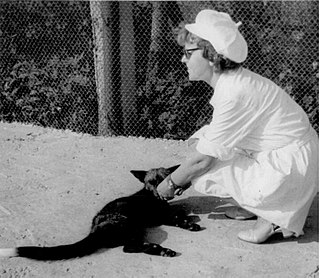
The domesticated silver fox is a form of the silver fox that has been to some extent domesticated under laboratory conditions. The silver fox is a melanistic form of the wild red fox. Domesticated silver foxes are the result of an experiment designed to demonstrate the power of selective breeding to transform species, as described by Charles Darwin in On the Origin of Species. The experiment at the Institute of Cytology and Genetics in Novosibirsk, Russia explored whether selection for behaviour rather than morphology may have been the process that had produced dogs from wolves, by recording the changes in foxes when in each generation only the most tame foxes were allowed to breed. Many of the descendant foxes became both tamer and more dog-like in morphology, including displaying mottled- or spotted-coloured fur.

The domestication of vertebrates is the mutual relationship between vertebrate animals including birds and mammals, and the humans who have influence on their care and reproduction.

Dmitry Konstantinovich Belyayev was a Soviet geneticist and academician who served as director of the Institute of Cytology and Genetics (IC&G) of the USSR Academy of Sciences, Novosibirsk, from 1959 to 1985. His decades-long effort to breed domesticated silver foxes was described by The New York Times as “arguably the most extraordinary breeding experiment ever conducted.” A 2010 article in Scientific American stated that Belyayev “may be the man most responsible for our understanding of the process by which wolves were domesticated into our canine companions.”

The dog is a domesticated descendant of the wolf. Also called the domestic dog, it is derived from the extinct Pleistocene wolf; the gray wolf is the dog's closest living relative. The dog was the first species to be domesticated by humans. Experts estimate that hunter-gatherers domesticated dogs more than 15,000 years ago, which was before the development of agriculture. Due to their long association with humans, dogs have expanded to a large number of domestic individuals and gained the ability to thrive on a starch-rich diet that would be inadequate for other canids.
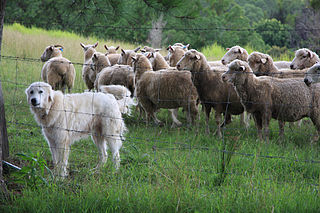
A livestock guardian dog (LGD) is a dog type bred for the purpose of protecting livestock from predators.

Dog types are broad categories of domestic dogs based on form, function, or style of work, lineage, or appearance. Some may be locally adapted dog types that may have the visual characteristics of a modern purebred dog. In contrast, modern dog breeds strictly adhere to long-established breed standards,[note 1] that began with documented foundation breeding stock sharing a common set of inheritable characteristics, developed by long-established, reputable kennel clubs that recognize the dog as a purebred.
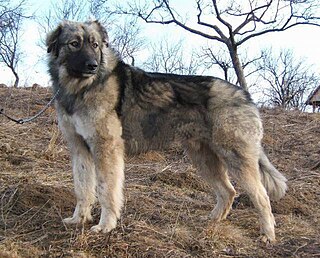
The Romanian Carpathian Shepherd Dog is a large breed of livestock guardian dogs that originated in the Carpathian Mountains of Romania.

A free-ranging dog is a dog that is not confined to a yard or house. Free-ranging dogs include street dogs, village dogs, stray dogs, feral dogs, etc., and may be owned or unowned. The global dog population is estimated to be 900 million, of which around 20% are regarded as owned pets and therefore restrained.

The Alopekis is a small, ancient, primitive landrace of dog from Greece and adjacent regions of the Balkan peninsula. Alopekis have prick ears, a curved tail, and a double coat. Alopekis were bred as a multipurpose farm dog, functioning as a hunting dog, watchdog and shepherd. The dog is found throughout Greece but is most commonly seen in northern Greek regions with a lot of farmland and villages, such as Serres, Drama, Xanthi, etc. Critically endangered, the exact number of specimens that remain today is unknown.
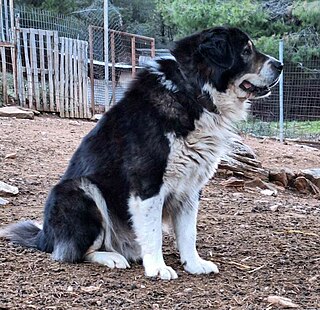
The Greek Shepherd or Greek Sheepdog is a breed of livestock guardian dog from Greece. Thought to be ancient in origin, the Greek Shepherd is very closely related to livestock guardian dog breeds from neighbouring countries; it is believed that some dogs are simultaneously claimed to be other breeds as they migrate annually across national borders with the flocks they protect in search seasonal pastures.
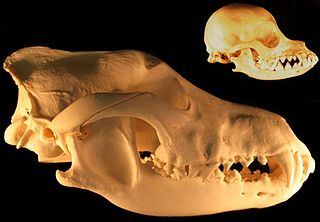
Domestication syndrome refers to two sets of phenotypic traits that are common to either domesticated plants or domesticated animals.
References
- ↑ Wade, Nicholas (November 22, 2002). "From Wolf to Dog, Yes, but When?". The New York Times. Archived from the original on November 12, 2020. Retrieved November 13, 2020.
- 1 2 "Hampshire College professor, noted dog expert, dies at 80". masslive. August 21, 2017. Retrieved November 18, 2020.
- 1 2 3 "In Memoriam: Raymond Coppinger". Hampshire College . Archived from the original on October 30, 2020. Retrieved November 18, 2020.
- ↑ Davis, Richie (April 1, 2016). "What is a dog? Ray and Lorna Coppinger's new book will tell you". The Greenfield Recorder. Archived from the original on June 9, 2016. Retrieved November 13, 2020.
- 1 2 Gorman, James (April 18, 2016). "The World is Full of Dogs Without Collars". The New York Times. Archived from the original on November 11, 2020. Retrieved November 13, 2020.
- ↑ "Ray Coppinger: Livestock Guardian Dogs in the US". January 17, 2018.
- ↑ "Editorial: The impact of Hampshire College's alums and faculty". Daily Hampshire Gazette. August 24, 2017. Archived from the original on August 26, 2017. Retrieved November 18, 2020.
- ↑ Gorman, James (December 3, 2019). "Why Are These Foxes Tame? Maybe They Weren't So Wild to Begin With". The New York Times. ISSN 0362-4331. Archived from the original on November 11, 2020. Retrieved November 18, 2020.
- ↑ MacLean, Colin. "A discovery at a small P.E.I. museum is challenging decades-old scientific research about domesticated foxes". www.saltwire.com. Archived from the original on November 18, 2020. Retrieved November 18, 2020.